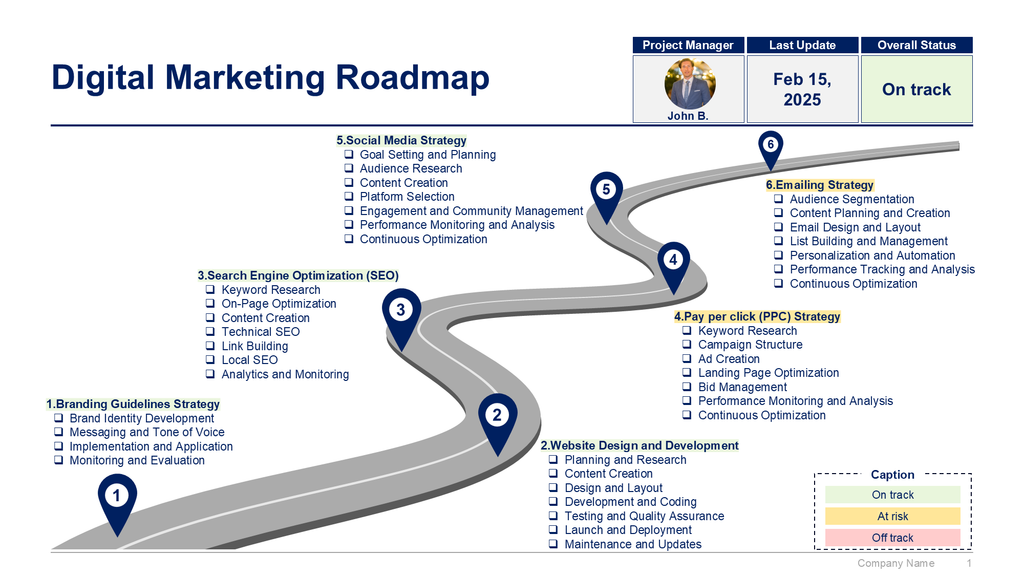Digital Marketing Roadmap - PPT Template and Guide

Download our Digital Marketing Roadmap PPT Template and Guide using a computer:
Introduction
In the ever-evolving landscape of digital marketing, having a well-structured roadmap is essential for achieving success. Here’s a comprehensive digital marketing roadmap that outlines key strategies and steps to take your marketing efforts to the next level.
1. Branding Guidelines Strategy:
Brand Identity Development: Establishing a clear understanding of your brand values, mission, and vision to guide all marketing activities.
Messaging and Tone of Voice: Ensuring consistent messaging and tone across all platforms to reinforce your brand identity.
Implementation and Application: Applying branding guidelines to all marketing materials and touchpoints.
Monitoring and Evaluation: Regularly reviewing and adjusting branding strategies to maintain relevance and effectiveness.
2. Website Design and Development:
Planning and Research: Conducting thorough research to understand user needs and preferences.
Content Creation: Developing engaging and relevant content that resonates with your audience.
Design and Layout: Focusing on user-friendly and visually appealing website design.
Development and Coding: Ensuring the website is functional, secure, and optimized for performance.
Testing and Quality Assurance: Testing for bugs and user experience issues before launch.
Launch and Deployment: Executing a solid plan for the website launch.
Maintenance and Updates: Regularly updating content and features to keep the website fresh and relevant.
3. Search Engine Optimization (SEO):
Keyword Research: Identifying relevant keywords to target in your content.
On-Page Optimization: Optimizing titles, meta descriptions, headings, and content for search engines.
Content Creation: Producing high-quality content that addresses users' queries and needs.
Technical SEO: Ensuring the website is fast, secure, and mobile-friendly.
Link Building: Building high-quality backlinks to improve domain authority.
Local SEO: Optimizing for local searches if your business serves a specific geographic area.
Analytics and Monitoring: Tracking performance metrics and adjusting strategies based on data insights.
4. Pay-Per-Click (PPC) Strategy:
Keyword Research: Selecting relevant and cost-effective keywords for PPC campaigns.
Campaign Structure: Organizing campaigns for maximum efficiency and effectiveness.
Ad Creation: Crafting compelling and relevant ads to attract clicks.
Landing Page Optimization: Ensuring landing pages are optimized for conversions.
Bid Management: Monitoring and adjusting bids to optimize campaign performance.
Performance Monitoring and Analysis: Analyzing campaign performance and making data-driven adjustments.
Continuous Optimization: Regularly refining and updating PPC strategies for ongoing improvement.
5. Social Media Strategy:
Goal Setting and Planning: Defining clear and achievable social media goals.
Audience Research: Understanding your audience's preferences and behaviors.
Content Creation: Developing engaging content tailored to each social media platform.
Platform Selection: Choosing the right social media platforms for your target audience.
Engagement and Community Management: Actively engaging with followers and building a community.
Performance Monitoring and Analysis: Tracking social media metrics and adjusting strategies based on insights.
Continuous Optimization: Regularly updating and refining your social media strategy for better results.
6. Emailing Strategy
Audience Segmentation: Segmenting your audience to deliver personalized email campaigns.
Content Planning and Creation: Developing valuable and relevant email content.
Email Design and Layout: Creating visually appealing and functional email designs.
List Building and Management: Growing and maintaining your email list.
Personalization and Automation: Using automation tools to deliver personalized emails at scale.
Performance Tracking and Analysis: Monitoring email metrics and making data-driven adjustments.
Continuous Optimization: Regularly refining and updating your email strategy for ongoing improvement.
Need more help? Check our Toolkits:
- Sales, Marketing & Communication Strategy Toolkit
- Digital Transformation and IT Strategy Toolkit
- Corporate/Business Strategy and Strategic Planning Toolkit


